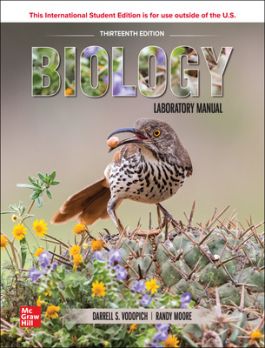Biology Laboratory Manual ISE
To access your eBook, sign in or register at McGraw Hill Bookshelf and you will be instructed to enter your access code.
After adding your eBook to the McGraw Hill Bookshelf, download the ReadAnywhere app on the App Store or Google Play. Sign into your McGraw Hill Bookshelf or Connect account to access your eBook on the go and download chapters for offline reading.
For McGraw Hill eBook & ReadAnywhere support, click here.
Exercise 2-Measurements in Biology: The Metric System and Data Analysis
Exercise 3-The Microscope: Basic Skills of Light Microscopy
Exercise 4-The Cell: Structure and Function
Exercise 5-Solutions, Acids, and Bases: The pH Scale
Exercise 6- Biologically Important Molecules: Carbohydrates, Proteins, Lipids, and Nucleic Acids
Exercise 7- Separating Organic Compounds: Column Chromatography, Paper Chromatography, and Gel Electrophoresis
Exercise 8- Spectrophotometry: Identifying Solutes and Determining Their Concentration
Exercise 9- Diffusion and Osmosis: Passive Movement of Molecules in Biological Systems
Exercise 10- Cellular Membranes: Effects of Physical and Chemical Stress
Exercise 11- Enzymes: Factors Affecting the Rate of Activity
Exercise 12- Respiration: Aerobic and Anaerobic Oxidation of Organic Molecules
Exercise 13- Photosynthesis: Pigment Separation, Starch Production, and CO2 Uptake
Exercise 14- Mitosis: Replication of Eukaryotic Cells
Exercise 15- Meiosis: Reduction Division and Gametogenesis
Exercise 16- Molecular Biology and Biotechnology: DNA Isolation and Genetic Transformation
Exercise 17- Genetics: The Principles of Mendel
Exercise 18- Evolution: Natural Selection and Morphological Change in Green Algae
Exercise 19- Human Evolution: Skull Examination
Exercise 20- Ecology: Diversity and Interaction in Plant Communities
Exercise 21- Community Succession
Exercise 22- Population Growth: Limitations of the Environment
Exercise 23- Pollution: The Effects of Chemical, Thermal, and Acidic Pollution
Exercise 24- Survey of Prokaryotes: Domains Archaea and Bacteria
Exercise 25- Survey of Protists: Algal Autotrophs
Exercise 26- Survey of Protists: Protozoan Heterotrophs
Exercise 27- Survey of the Kingdom Fungi: Molds, Sac Fungi, Mushrooms, and Lichens
Exercise 28- Survey of the Plant Kingdom: Liverworts, Mosses, and Hornworts of Phyla Hepatophyta, Bryophyta, and Anthocerophyta
Exercise 29- Survey of the Plant Kingdom: Seedless Vascular Plants of Phyla Pterophyta and Lycophyta
Exercise 30- Survey of the Plant Kingdom: Gymnosperms of Phyla Cycadophyta, Ginkgophyta, Coniferophyta, and Gnetophyta
Exercise 31- Survey of the Plant Kingdom: Angiosperms
Exercise 32- Plant Anatomy: Vegetative Structure of Vascular Plants
Exercise 33- Plant Physiology: Transpiration
Exercise 34- Plant Physiology: Tropisms, Nutrition, and Growth Regulators
Exercise 35- Bioassay: Measuring Physiologically Active Substances
Exercise 36- Survey of the Animal Kingdom: Phyla Porifera and Cnidaria
Exercise 37- Survey of the Animal Kingdom: Phyla Platyhelminthes and Mollusca
Exercise 38- Survey of the Animal Kingdom: Phyla Annelida and Nematoda
Exercise 39- Survey of the Animal Kingdom: Phylum Arthropoda
Exercise 40- Survey of the Animal Kingdom: Phyla Echinodermata and Chordata
Exercise 41- Vertebrate Animal Tissues: Epithelial, Connective, Muscular, and Nervous Tissues
Exercise 42- Human Biology: The Human Skeletal System
Exercise 43- Human Biology: Muscles and Muscle Contraction
Exercise 44- Human Biology: Breathing
Exercise 45- Human Biology: Circulation and Blood Pressure
Exercise 46- Human Biology: Sensory Perception
Exercise 47- Vertebrate Anatomy: External Features and Skeletal System of the Rat
Exercise 48- Vertebrate Anatomy: Muscles and Internal Organs of the Rat
Exercise 49- Vertebrate Anatomy: Urogenital and Circulatory Systems of the Rat
Exercise 50- Embryology: Comparative Morphologies and Strategies of Development
Exercise 51- Animal Behavior: Taxis, Kinesis, and Agonistic Behavior
Appendix I- Dissection of a Fetal Pig
Appendix II- Conversion of Metric Units to English Units
Additionally, with McGraw Hill Connect, powerful digital tools augment lab instruction by helping students apply their knowledge in a laboratory setting. Connect Virtual Labs can be implemented in a hybrid or fully online setting to help students prepare for the wet lab and strengthening their lab experience.
McGraw Hill Connect is an award-winning digital teaching and learning solution that empowers students to achieve better outcomes and enables instructors to improve course management efficiency.
High-Quality Course Material
Our trusted solutions are designed to help students actively engage in course content and develop critical higher-level thinking skills while offering you the flexibility to tailor your course to the ways you teach and the ways your students learn.
Assignments & Automatic Grading
Connect features a question bank that you can select from to create homework, practice tests and quizzes. Dramatically reduce the amount of time you spend reviewing homework and grading quizzes, freeing up your valuable time to spend on teaching.
Analytics & Reporting
Monitor progress and improve focus with Connect’s visual and actionable dashboards. Reports are available to empower both instructors and students with real-time performance analytics.
Seamless Integration
Link your Learning Management with Connect for single sign-on and gradebook synchronization, with all-in-one ease for you and your students.


